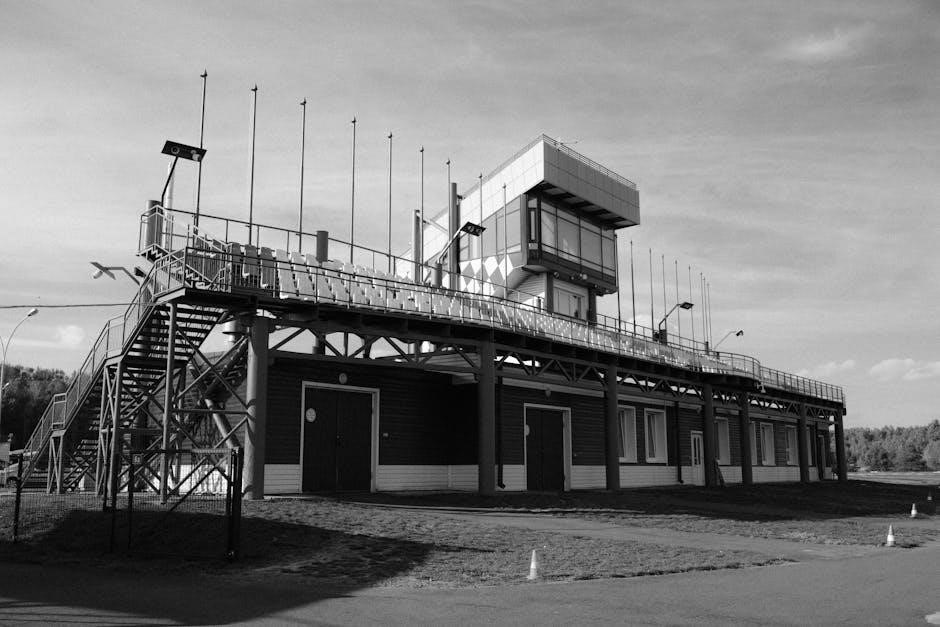A reliable outboard motor stand is essential for maintaining, storing, and transporting your motor securely. Building a custom stand offers convenience, flexibility, and cost-effectiveness. PDF guides provide detailed plans and step-by-step instructions, making it easier for DIY enthusiasts to construct a sturdy and durable stand tailored to their needs.
Importance of a Sturdy Outboard Motor Stand

A sturdy outboard motor stand is essential for protecting your motor from damage and ensuring safe handling. It provides a stable base for maintenance, storage, and transportation, preventing accidental tipping. A well-built stand supports the motor’s weight evenly, reducing strain on the engine and mounting hardware. It also keeps the motor off the ground, minimizing exposure to moisture and contaminants that can cause rust or corrosion. A reliable stand enhances safety by preventing heavy motors from falling and causing injury. Investing in a durable stand ensures your outboard motor remains in excellent condition, extending its lifespan and performance reliability.
Benefits of Using Outboard Motor Stand Plans
Using outboard motor stand plans offers numerous advantages for DIY enthusiasts and boat owners. Plans provide a clear, step-by-step guide, ensuring your stand is built to precise specifications. They save time by eliminating guesswork and reduce costs by optimizing material usage. Customizable designs allow you to tailor the stand to your motor’s size and weight, ensuring a perfect fit. Detailed instructions make the project accessible even for those with limited construction experience. With plans, you can create a sturdy, functional stand that enhances safety, storage, and maintenance efficiency for your outboard motor. This ensures a professional-grade result without hiring experts.
Overview of the Article
This article provides a comprehensive guide to building a sturdy outboard motor stand using detailed PDF plans. It covers essential topics such as materials, tools, and step-by-step construction processes. The guide emphasizes safety, durability, and customization, ensuring the stand meets your specific needs. Whether you’re a DIY enthusiast or a boat owner, this resource offers practical advice and tips to help you create a reliable and functional motor stand. By following the outlined instructions, you’ll be able to construct a stand that enhances storage, maintenance, and overall motor protection.

Materials and Tools Required
The PDF guide provides a detailed list of materials like durable aluminum or steel frames, wood for the stand, and essential hardware. Tools include drills, wrenches, and saws.

list of Materials for the Stand
The PDF plans specify materials like sturdy steel or aluminum for the frame, marine-grade wood for the base, and durable hardware such as bolts, brackets, and clamps. Stainless steel fasteners are recommended for corrosion resistance. Aluminum piping or rectangular tubing is ideal for the motor mounts, while rubber padding ensures protection for the motor. Additional materials include a waterproof coating for wood surfaces and optional caster wheels for mobility. A comprehensive list ensures all components are readily available, making the construction process efficient and straightforward. Proper material selection guarantees durability and stability for the outboard motor stand.
Tools Needed for Construction
The PDF plans outline essential tools for building the stand, including a saw for cutting wood or metal, a drill for creating holes, and a wrench for tightening bolts. A tape measure and square ensure precise measurements and alignment. Sandpaper or a grinder may be needed for smoothing surfaces. Safety gear like gloves and safety glasses is recommended. If welding is required, a welder and protective gear are necessary. Additional tools include clamps for holding parts in place and a level to ensure the stand is even. Having these tools ready streamlines the construction process and ensures accuracy. Proper tool preparation is key to a successful build.

Step-by-Step Instructions
Follow the PDF guide to build your outboard motor stand; Begin by assembling the frame, then install the mounts. Add wheels for mobility and finish with a thorough inspection.
Assembling the Frame
Begin by gathering all materials and tools as per the PDF plans. Cut the lumber to specified lengths, ensuring precise measurements; Use bolts or screws to secure the frame pieces together, forming a sturdy base. Align the sides evenly and check for plumb using a level. Tighten all connections firmly to avoid wobbling. If needed, reinforce joints with additional brackets for extra stability. Double-check all bolts and ensure the frame is square before proceeding to the next step. A solid frame is crucial for safely supporting the motor’s weight. Follow the plans carefully for optimal results.
Attaching the Motor Mounts
Position the motor mounts according to the PDF plans, ensuring proper alignment with the frame. Mark the mounting points accurately and drill pilot holes to avoid splitting the wood. Secure the mounts using high-strength bolts and washers, tightening them firmly. Apply a small amount of marine-grade sealant around the edges for added durability. Use a level to ensure the mounts are perfectly aligned and balanced; Double-check the weight capacity of the mounts to match your motor’s specifications. Once attached, test the stability by placing the motor on the stand, ensuring it sits level and secure.
Adding Wheels or Handles for Portability

For enhanced portability, attach heavy-duty caster wheels or sturdy handles to your outboard motor stand. Refer to the PDF plans for optimal placement. Wheels should be securely bolted to the frame’s base, ensuring smooth movement across various surfaces. Handles, made of metal or durable plastic, should be positioned for easy lifting and maneuvering. Ensure all hardware is tightly fastened to prevent loosening over time. This addition allows easy transportation of your motor, making storage and maintenance more convenient. Choose wheels with a swivel feature for better mobility and consider locking mechanisms to keep the stand stable when stationary. Portability enhances functionality and accessibility.
Final Touches and Inspection
Once the stand is assembled, perform a thorough inspection to ensure all components are secure and properly aligned. Tighten any loose bolts or screws and verify the stand’s stability. Sand any rough edges or surfaces for safety. Apply a rust-resistant coating or paint to protect the metal from corrosion. Double-check the motor mounts and wheels for proper functionality. Ensure the stand is level and can hold the motor’s weight evenly. Finally, test the stand by placing the motor on it and checking for wobbling or instability. Make any necessary adjustments before declaring the project complete and ready for use.

Safety Considerations
Ensure the stand is stable and balanced to prevent accidents. Protect the motor from environmental elements like rain or sun exposure. Secure all electrical and fuel systems properly.
Stability and Balance of the Stand
A stable outboard motor stand is crucial to prevent accidents and ensure safe operation. The stand must be designed with a low center of gravity and even weight distribution. Use sturdy materials and ensure all joints are secure. Always place the stand on firm, level ground to maintain balance. Test the stand with the motor attached to confirm it doesn’t wobble or tip. Consider adding features like wide legs or outriggers for extra stability. Regularly inspect the stand for any signs of wear or damage. A stable stand protects your motor and ensures safety during maintenance or storage. Prioritize balance in your design.
Protection from Environmental Elements
Protecting your outboard motor stand from environmental elements is essential for longevity. Exposure to rain, humidity, and saltwater can cause rust and corrosion. Use materials like galvanized steel or marine-grade aluminum to withstand harsh conditions. Apply a waterproof sealant or marine paint to all metal surfaces. Store the stand in a dry, shaded area when not in use. For coastal environments, consider adding a protective coating to resist saltwater damage. Regularly clean and inspect the stand to prevent dirt buildup. Covering the motor with a breathable cover can also shield it from dust and moisture. Proper protection ensures durability and reliable performance.
Electrical and Fuel System Safety
Ensuring the safety of electrical and fuel systems is critical when building an outboard motor stand. Always use marine-grade materials for wiring and fuel lines to prevent degradation. Secure all connections tightly to avoid leaks or sparks. Regularly inspect for cracks, frays, or corrosion. Ensure proper ventilation to prevent fuel fume buildup. Keep electrical components away from heat sources and moisture. Follow manufacturer guidelines for system maintenance and upgrades. Proper care ensures safe and reliable operation.

Design and Construction Tips
Design your stand by assessing motor size and weight for proper support, ensuring durability, and optimizing space for easy access and maintenance efficiency.
Considering Motor Size and Weight
Always match your stand design to the motor’s size and weight specifications. Measure the motor’s length, width, and horsepower to ensure proper support. Heavier motors require sturdier frames, while smaller ones need less robust structures. Consider the torque and balance point to maintain stability. Use materials that can handle the weight without bending or warping. For larger motors, reinforce the stand with additional brackets or crossbeams. Ensure the stand’s height adjusts to fit the motor securely, preventing wobbling or strain. Consulting the motor’s manufacturer guidelines will help tailor the stand accurately for safe and reliable performance.
Space Constraints and Layout
Plan your stand’s layout to fit available workspace, ensuring easy access for maintenance. Compact designs are ideal for small garages or workshops. Consider foldable or collapsible features to save space when not in use. Ensure the stand’s footprint allows movement around it without obstruction. Adjustable widths and heights can accommodate various motor sizes while optimizing space. Measure your workspace beforehand to avoid overcrowding. Integrating storage for tools or accessories can enhance functionality without adding bulk. Prioritize a layout that balances accessibility with efficiency, making the most of limited areas while keeping the stand practical and user-friendly.
Material Selection for Durability
Selecting the right materials ensures your outboard motor stand withstands heavy use and harsh conditions. Aluminum and steel are top choices due to their strength-to-weight ratio and resistance to corrosion. Stainless steel fasteners are ideal for preventing rust and ensuring long-term durability. Consider using marine-grade materials to protect against saltwater exposure. Reinforced brackets and a sturdy frame design add stability. Prioritize materials with UV resistance if the stand will be exposed to sunlight. Welded joints are preferable over bolted ones for added strength. A durable powder-coated or marine-grade paint finish can further protect the stand from environmental elements, ensuring longevity and reliability.
Customization Options
Customize your stand with additional storage compartments, personalized paint finishes, and tailored designs for specific motor sizes to enhance functionality, aesthetics, and durability.
Adding Additional Storage
Enhance your outboard motor stand by incorporating storage solutions such as shelves, compartments, or drawers. These additions provide space for tools, fuel, and accessories, keeping essentials within easy reach. Consider using durable materials like aluminum or heavy-duty plastic for storage components to ensure longevity. You can also add customizable compartments tailored to specific items, such as oil filters or spark plugs. For added security, include locking mechanisms to protect valuable equipment. This feature not only improves functionality but also keeps your workspace organized and clutter-free, making maintenance and repairs more efficient. Ensure storage additions are securely attached to the stand’s frame for stability.
Personalizing the Stand for Specific Motors
Customize your outboard motor stand to fit your motor’s unique specifications for optimal performance and compatibility. Measure the motor’s dimensions to ensure the stand’s frame and mounts align perfectly. Consider the weight and horsepower of your motor when selecting materials and designing the support structure. Add adjustable brackets or padding to accommodate different motor sizes or styles. Incorporate features like tilt mechanisms or swivel options for easier maintenance and storage. Personalization ensures a secure fit, reducing vibration and stress on the motor. This tailored approach enhances functionality and extends the lifespan of both the stand and the motor, making it a worthwhile investment.

Maintenance and Storage
Regularly inspect and clean the stand to prevent rust or damage. Lubricate moving parts and tighten bolts for stability. Store in a dry, shaded area to protect from elements. Ensure the motor is securely attached during storage for safety and longevity.
Regular Maintenance Checks
Perform regular maintenance checks to ensure the outboard motor stand remains stable and functional. Inspect for any signs of damage, wear, or rust, and address issues promptly. Lubricate all moving parts to prevent corrosion and ensure smooth operation. Check bolts and screws for tightness, as loosening can compromise stability. Clean the stand thoroughly, removing dirt or debris that may accumulate. Regularly apply a protective coating to metal components to prevent rust. Ensure the motor is securely attached during storage to avoid accidental damage. Neglecting maintenance can lead to instability or structural failure, risking both the stand and the motor.
Proper Storage Techniques
Proper storage techniques are essential for maintaining the longevity of your outboard motor stand. Ensure the stand is clean and dry before storing to prevent rust or corrosion. Use a protective covering or tarp to shield it from dust and moisture. Store the stand in a cool, dry location, away from direct sunlight, to avoid warping or fading. If storing for extended periods, elevate the stand on blocks or pallets to protect it from ground moisture. Secure the motor firmly to the stand using straps or brackets to prevent movement during storage. For added protection, apply a rust-inhibiting coating to metal components. Regularly inspect stored items to ensure no damage occurs. Proper storage ensures your stand remains in excellent condition for future use.
troubleshooting Common Issues

Troubleshooting Common Issues
Common issues with outboard motor stands include wobbling, structural weakness, or rust. Tighten loose bolts, reinforce joints, and apply rust inhibitors to resolve these problems effectively.
Addressing Wobbling or Instability
Wobbling or instability in an outboard motor stand can compromise safety and functionality. Begin by ensuring the stand is placed on a level surface. Check for loose bolts and tighten them firmly. Inspect the frame for weak joints and reinforce them with metal brackets or additional support beams. If the stand has wheels, ensure they are securely locked or consider adding stabilizing feet. For homemade stands, verify that the design proportions match the motor’s weight and size. Regularly inspect and tighten all connections to maintain stability and prevent accidental tipping during transport or storage.
Repairing Damaged Parts
Repairing damaged parts of your outboard motor stand ensures long-term reliability. Start by assessing the extent of the damage to determine the necessary materials. For metal frames, weld or replace rusted sections. Wooden stands may require sanding and reinforcing with epoxy or new lumber. If bolts or fasteners are corroded, replace them with marine-grade hardware. For plastic or composite components, use adhesive compounds or replace the part entirely. Always refer to your PDF plans for specific instructions. After repairs, apply a protective finish, such as paint or sealant, to prevent further deterioration. Regular inspections can help catch issues before they escalate.
Where to Find Outboard Motor Stand Plans
Find outboard motor stand plans in PDF format on websites like eBay, Amazon, or specialized marine forums. Check manufacturer websites or DIY project platforms for downloadable guides.
Downloading PDF Guides Online
Downloading PDF guides for outboard motor stands is convenient and straightforward. Websites like eBay, Amazon, and marine supply stores offer downloadable plans. Ensure the PDF is detailed, including measurements, materials, and step-by-step instructions. Look for guides with reviews or ratings to confirm reliability. Many plans are designed by experts or DIY enthusiasts, offering proven designs. Secure your download from trusted sources to avoid malware. These guides often include customization options and tips for various motor sizes. Save time by selecting a PDF that matches your skill level and project needs for a smooth building experience.
Recommended Websites and Resources
For reliable outboard motor stand plans, visit websites like eBay, Amazon, or marine supply stores. Instructables and Pinterest offer DIY guides, while forums like BoatDesign.net and HullTruth provide community-shared designs. Check out specialized platforms like MyBoatPlans or Boatbuilding.org for detailed blueprints. Many websites offer free or paid PDF downloads, ensuring you find plans that suit your needs. Look for reviews or ratings to ensure quality and accuracy. These resources often include additional tips and support, making your project easier and more successful. Always verify the source’s credibility to ensure safe and secure downloads.
Thank you for your attention! Building an outboard motor stand is a rewarding project that enhances safety and convenience. Start your project today and enjoy the benefits!
Final Thoughts on Building a Stand
Constructing an outboard motor stand is a practical and rewarding DIY project that ensures safety, convenience, and protection for your motor. With proper planning and execution, you can create a durable and customized stand tailored to your specific needs. Remember to follow detailed plans, use high-quality materials, and prioritize stability and balance. The satisfaction of building something yourself, combined with the functionality it provides, makes this project well worth the effort. Whether you’re storing your motor temporarily or for an extended period, a well-built stand will serve you reliably for years to come.
Encouragement to Start the Project
Embarking on building an outboard motor stand is a cost-effective and rewarding endeavor that ensures your motor’s safety and accessibility. With clear PDF plans guiding you, the process is straightforward and manageable even for those new to DIY projects. The satisfaction of creating something functional and tailored to your needs is immense. By starting today, you’ll not only enhance your storage solutions but also gain hands-on experience; Don’t hesitate—gather your materials, follow the instructions, and enjoy the pride of crafting a durable stand that protects your motor and simplifies maintenance.